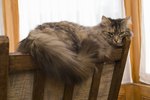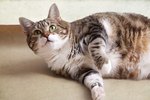Cats are genetically predisposed to consuming high protein and low carbohydrates, but if they eat processed cat foods high in carbohydrates, they may become diabetic, which means they are unable to produce enough insulin to balance blood sugar and glucose levels. High glucose levels can contribute to dehydration, frequent urination and loose stools. Diabetes can be easily managed in felines, but it is important to know the right way to maintain your cat's health.
Causes
Loose stool (diarrhea) in your cat can result from poor diabetic treatment and monitoring. According to Cornell University, "Diabetes will shorten a cat's lifespan. A dangerous, sometimes fatal condition called ketoacidosis may develop, indicated by loss of appetite, vomiting, diarrhea, lethargy, weakness, dehydration, and breathing abnormalities." Along with excessive urination, loose stool in diabetic cats develops from hyperglycemia, or high blood sugar levels, which will begin to turn excess sugar into glucosuria. When glucosuria builds up in the blood stream, the cat's body responds by flushing it out in urine and runny stool.
Diet Treatment
Feline diabetes can be controlled and treated with a well-monitored diet plan. Cats need a diet high in fiber and low in sugar (carbohydrates) to maintain proper insulin levels and to decrease digestion problems associated with diabetes.
Insulin Treatment
Insulin, a hormone produced in the pancreas, is responsible for regulating sugar levels. When insulin is deficient, the cat's body starts breaking down fat and protein and, instead of storing it, uses it for an alternative energy source. As a result, a feline can develop a ravenous appetite and have frequent urination and loose stool. To correct poor insulin levels, diabetic cats require insulin injections. Dosage is determined by the veterinarian based on the severity of the cat's diabetes. Adverse side effects resulting from insulin shots can include vomiting, loss of appetite and diarrhea. A special diet can offset some of these side effects.
Digestion
According to Pet Doc, diabetic cats can sometimes suffer from gastrointestinal problems--most commonly, vomiting and diarrhea. Insulin injections, prescription medications and certain specialty foods can have grave effects on a cat's digestion, resulting in upset stomach and loose bowels. Therefore, it is important that cats stay hydrated when undergoing any type of treatment. Hydration can help regulate or improve a poor appetite (a common problem in diabetic cats suffering from dehydration and loose bowels). Because proper hydration can reduce diarrhea, it contributes to improving food nutrient absorption, speeding up the recovery process while lessening diabetic symptoms. Cats need clean and fresh water available at all times.
Monitoring
Monitoring a diabetic cat is extremely important in order to prevent symptoms and to keep the cat's condition from worsening. (While diabetes in cats is highly treatable, improper monitoring and treatment can lead to death.) Glucose test strips can be used in urine samples and loose stool samples to determine whether a cat has dangerously high glucose levels. Consult a veterinarian about the monitoring process. Dehydration is dangerous. Making sure your cat drinks enough water can keep the cat's glucose levels down. Cats recovering from loose stool should be given water in small amounts to start; give the cat an ice cube to lick or small doses of water through a syringe. Some veterinarians recommend that diabetic cats drink fluids abundant in electrolytes; cats may be given example Pedialyte, an infant formula that helps replenish minerals and vitamins after diarrhea, frequent urination or excessive vomiting.





